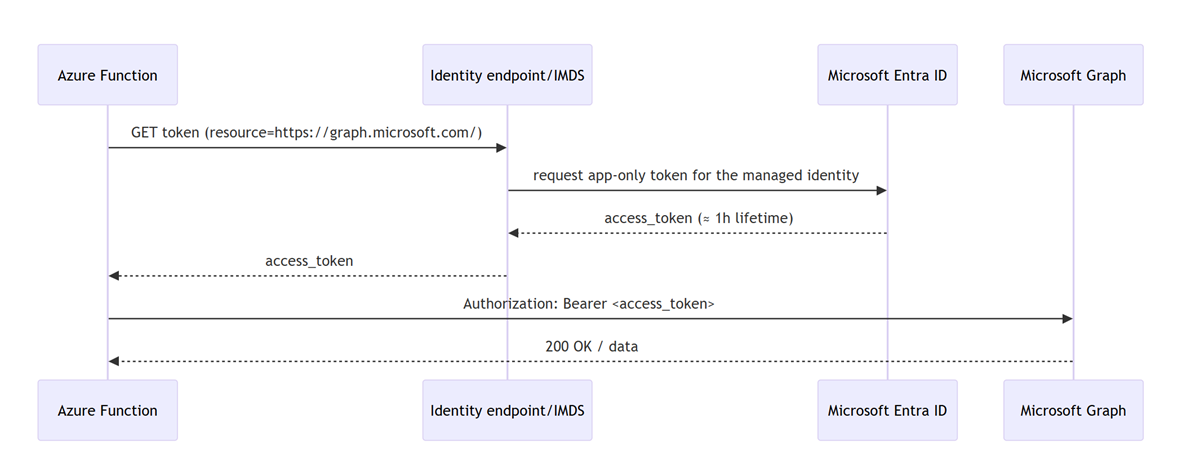Building Azure functions that never store secrets — ever
What if your function could hit Microsoft Graph with no client secrets, no certs, and no Key Vault entries? That is exactly what a Managed identity is for: Azure issues short-lived tokens to your app on demand, and the platform rotates and protects the underlying credentials for you.
The problem: credential hell
// the old way — credential nightmare
const clientSecret = process.env.CLIENT_SECRET; // 🚨 secret in env vars
const certificatePath = './certs/app-cert.pfx'; // 🚨 cert lifecycle
const connectionString = "DefaultEndpointsProtocol=…"; // 🚨 another secret
// what goes wrong?
// - secrets expire; prod breaks
// - certificates need attention
// - secrets get committed to git (oops)
// - Key Vault becomes a hard dependency
// - drift across environments
💡 Secrets create operational drag and failure modes you do not need in Azure. Managed identity removes them.
The solution: Managed identity in one picture
At runtime your function asks the platform for a token; Azure verifies the function’s identity and returns a short-lived OAuth 2.0 access token for Microsoft Graph, which your code uses as a bearer token. No app-held secret is involved.

Minimal code: fetch a token, call graph
import type { AzureFunction, Context, HttpRequest } from "@azure/functions";
const httpTrigger: AzureFunction = async (context: Context, req: HttpRequest) => {
// IMDS pattern; works broadly, especially on VMs and newer stacks
const tokenUrl = "http://169.254.169.254/metadata/identity/oauth2/token" +
"?api-version=2018-02-01&resource=https://graph.microsoft.com/";
const tokenResp = await fetch(tokenUrl, { headers: { "Metadata": "true" } });
const { access_token } = await tokenResp.json();
const resp = await fetch("https://graph.microsoft.com/v1.0/groups", {
headers: { Authorization: `Bearer ${access_token}`, "Content-Type": "application/json" }
});
context.res = { status: resp.status, body: await resp.json() };
};
Why this is safe: the Instance Metadata Service (IMDS) lives at a non-routable address 169.254.169.254, is reachable only from inside the host, and communication to IMDS never leaves the host. The response includes expires_in (typically 3599 seconds), roughly an hour.
Production tip: on App Service/Functions prefer the local identity endpoint (
IDENTITY_ENDPOINT+X-IDENTITY-HEADER), which the runtime exposes for you. The Azure Identity SDK (DefaultAzureCredentialorManagedIdentityCredential) wraps this nicely.
// pattern for App Service/Functions local identity endpoint
const { IDENTITY_ENDPOINT, IDENTITY_HEADER } = process.env;
async function getGraphToken(): Promise<string> {
if (IDENTITY_ENDPOINT && IDENTITY_HEADER) {
const u = `${IDENTITY_ENDPOINT}?api-version=2019-08-01&resource=https://graph.microsoft.com/`;
const r = await fetch(u, { headers: { "X-IDENTITY-HEADER": IDENTITY_HEADER } });
const j = await r.json();
return j.access_token;
}
// IMDS fallback
const imds = "http://169.254.169.254/metadata/identity/oauth2/token" +
"?api-version=2018-02-01&resource=https://graph.microsoft.com/";
const r = await fetch(imds, { headers: { "Metadata": "true" } });
const j = await r.json();
return j.access_token;
}
The bootstrap: Who gives the function permission to call graph?
The Managed identity eliminates stored credentials, but it does not auto-grant API permissions. You must assign Microsoft Graph application permissions (app roles) to the function’s service principal at deploy time. Use the Graph app role assignment API and the least-privileged permissions to call it.
Required rights for the caller
Use AppRoleAssignment.ReadWrite.All plus Application.Read.All, or run under a directory role such as Cloud Application Administrator or Application Administrator. These are the least-privileged choices documented for assigning app roles.
Reliably target the Graph service principal
Do not search by display name. Address Microsoft Graph by its well-known appId and query its app roles:
servicePrincipals(appId='00000003-0000-0000-c000-000000000000')
Three IDs you need for each assignment
principalId: your function app’s managed identity service principal idresourceId: the Graph service principal idappRoleId: the specific Graph application permission you want (for example,Directory.Read.All), found in Graph’sappRolescollection
Example: assign Directory.Read.All and Group.Read.All to the function’s identity
$graphSp = az rest `
--method GET `
--uri "https://graph.microsoft.com/v1.0/servicePrincipals(appId='00000003-0000-0000-c000-000000000000')`?$select=id,appRoles" `
--query "id" -o tsv
# function's managed identity service principal id
$miSpId = $principalId # e.g., from your Bicep output
# find the appRoleIds you need programmatically
$roles = az rest --method GET `
--uri "https://graph.microsoft.com/v1.0/servicePrincipals/$graphSp?`$select=appRoles" `
--query "appRoles[?value=='Directory.Read.All' || value=='Group.Read.All'].{value:value,id:id}" -o json
# assign each role
$roles | ConvertFrom-Json | ForEach-Object {
$payload = @{ principalId = $miSpId; resourceId = $graphSp; appRoleId = $_.id } | ConvertTo-Json
$tmp = New-TemporaryFile
$payload | Out-File -FilePath $tmp -Encoding utf8
az rest --method POST `
--uri "https://graph.microsoft.com/v1.0/servicePrincipals/$miSpId/appRoleAssignments" `
--headers "Content-Type=application/json" `
--body "@$tmp" | Out-Null
Remove-Item $tmp -Force
}
Security model; what is and is not leaving your app
- No long-lived credentials in your app. The underlying SP keys and certs are platform-managed; your code never handles them
- Token requests stay local to the host. Calls to IMDS use
169.254.169.254and never leave the host - Access tokens are bearer tokens. You do receive the access token in your app; protect it like any other bearer token. The win here is that it is short-lived and you do not store a secret. The platform rotates the identity for you
Why this matters
| traditional | zero-credential (managed identity) |
|---|---|
| secrets in code/config/Key Vault | no app-held secrets; platform-issued tokens |
| manual rotation of secrets/certs | platform rotates credentials; you request new tokens when needed |
| risk of leaks via git/logs | no long-lived secrets to leak; token request is host-local |
| secret management infra | none for Graph; you manage permissions, not secrets |
| outages from expired secrets | short-lived tokens; transparent renewal via the platform |
Grab-and-go snippets
IMDS token request (HTTP semantics, including
expires_in):GET http://169.254.169.254/metadata/identity/oauth2/token?api-version=2018-02-01&resource=https://graph.microsoft.com/with headerMetadata: true.App Service/Functions identity endpoint (raw HTTP example, required headers):
GET /MSI/token?resource=https://graph.microsoft.com/&api-version=2019-08-01with headerX-IDENTITY-HEADER: <IDENTITY_HEADER>to the host inIDENTITY_ENDPOINT.Assign Graph app role to a service principal and required permissions for the caller:
POST https://graph.microsoft.com/v1.0/servicePrincipals/{id}/appRoleAssignmentswithprincipalId,resourceId, andappRoleId; caller needsAppRoleAssignment.ReadWrite.All+Application.Read.All(or a suitable directory role).
And now, please stop using secrets if you don’t have to 😇
You May Also Like
Round Robin assignments in Power Automate
Tired of assigning tasks manually? Try a round robin setup in Power Automate! With SharePoint as memory and your Teams group as the source, this flow rotates assignments automagically 🦄.
Stop using GitHub Copilot as a chatbot!
Chat feels natural, but software engineering is not a conversation. This post explains why conversational interaction models optimize for negotiation, not commitment; and why treating GitHub Copilot …
You are holding GitHub Copilot Wrong!
If you’re constantly prompting, re-prompting, and steering GitHub Copilot, you’re using it wrong. This post explains why the problem isn’t your prompts, but the interaction model itself.





